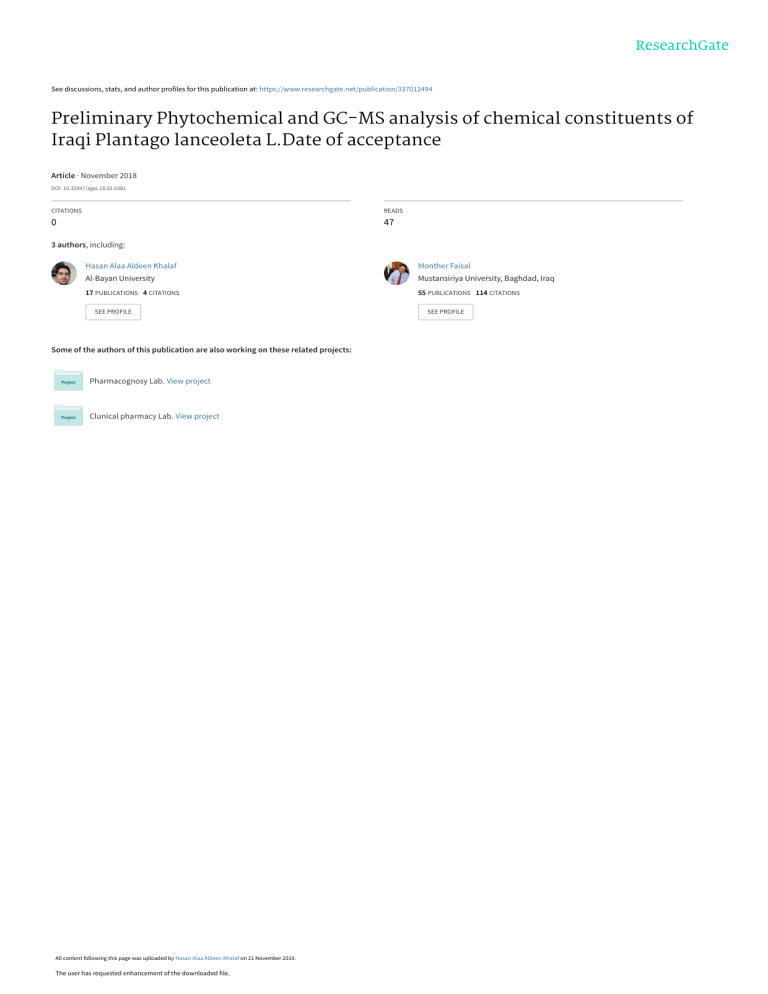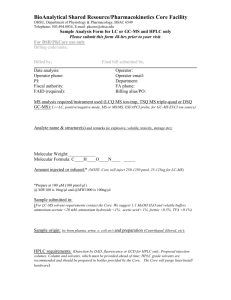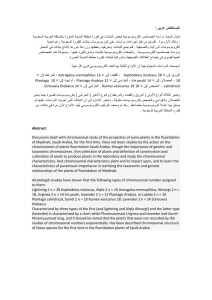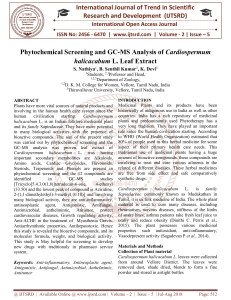Phytochemical & GC-MS Analysis of Iraqi Plantago lanceoleta L.
advertisement

See discussions, stats, and author profiles for this publication at: https://www.researchgate.net/publication/337012494 Preliminary Phytochemical and GC-MS analysis of chemical constituents of Iraqi Plantago lanceoleta L.Date of acceptance Article · November 2018 DOI: 10.32947/ajps.18.02.0381 CITATIONS READS 0 47 3 authors, including: Hasan Alaa Aldeen Khalaf Monther Faisal Al-Bayan University Mustansiriya University, Baghdad, Iraq 17 PUBLICATIONS 4 CITATIONS 55 PUBLICATIONS 114 CITATIONS SEE PROFILE Some of the authors of this publication are also working on these related projects: Pharmacognosy Lab. View project Clunical pharmacy Lab. View project All content following this page was uploaded by Hasan Alaa Aldeen Khalaf on 21 November 2019. The user has requested enhancement of the downloaded file. SEE PROFILE AJPS, 2018, Vol. 18, No.2 Date of acceptance: 4-11-2018 Preliminary Phytochemical and GC-MS analysis of chemical constituents of Iraqi Plantago lanceoleta L. Hasan Alaa Al-deen Khalaf*, Monther Faisal Mahdi**, Ibrahim Salah *Abaas *Department of Pharmacognosy and Medicinal Plants, College of Pharmacy, Mustansiriya University, Baghdad-Iraq. **Department of Pharmaceutical Chemistry, College of Pharmacy, Ashur University, Baghdad-Iraq. Hasan.alaa84@yahoo.com DOI: https://doi.org/10.32947/ajps.18.02.0381 ــــــــــــــــــــــــــــــــــــــــــــــــــــــــــــــــــــــــــــــــــــــــــــــــــــــــــــــــــــــــــــــــــــــــــــــــــــــــــــــــــــــــــــــــــــــــــــــــــــــــــــــــــــ Abstract: Plantago lanceoleta L. is one of medicinally important plant that officially registered in British pharmacopoeia. One of their well-known common name is ribwort, which is rich in many phytochemical compounds. The goal of this study is the qualitative evaluation of the Iraqi plant by identifying its chemical constituents. The plant was authenticated, collected, and immediately subjected to a stream of air under room temperature for rapid drying. Each part of the plant extracted separately with 50% ethanol and tested for presence of iridoid glycosides, tannins, flavonoids, terpenoids, alkaloids and saponins. While the other part of phytochemical screening of Iraqi P. lanceoleta L. in this work is the chromatographic fingerprint analysis of n-hexane extract of the plant leaves by gas chromatography-mass spectrometry (GC-MS). The result obtained show that Iraqi P. lanceoleta L. is rich in iridoid glycosides and tannins in each part of the plant, while the chromatogram of GC-MS show that the Iraqi plant contains high amount of hydrocarbons, fatty acids, steroids, terpenoids and other constituents. Key words: Plantago lanceoleta L., preliminary tests, GC-MS, n-hexane extract فحوصات أوليه كيميائيه لنبات لسان الحمل ألسهمي وتحليل مكوناته بواسطة جهاز كروماتوكرافيا الغاز المرتبطه بمطياف الكتله )(GC-MS حسن عالء الدين خلف* منذر فيصل مهدي** أبراهيم صالح عباس*** *فرع العقاقير و النباتات الطبيه ،قسم الصيدله ،الجامعه المستنصريه ،بغداد-العراق **فرع الكيمياء الصيدالنيه ،قسم الصيدله ،كلية اشور الجامعه ،بغداد-العراق ***فرع العقاقير و النباتات الطبيه ،قسم الصيدله ،الجامعه المستنصريه ،بغداد-العراق الخالصة: لسان الحمل السهمي هي أحد النباتات الطبية الهامة المسجلة رسميا في دستور األدوية البريطانية .واحد من االسماء الشائعه المعروفه لهذا النبات هو لسان الحمل السناني ،وهو غني بالعديد من المركبات الكيميائية النباتية .الهدف من هذه الدراسة هو التقييم النوعي للنبات العراقي من خالل تحديد مكوناته الكيميائية .تمت المصادقة على النبات وجمعه وتقسيمه إلى أربعة أجزاء (األوراق والسيقان والبذور والجذور) وتعرض على الفور إلى تيار من الهواء تحت درجة حرارة الغرفة للتجفيف السريع .كل جزء من النبات استخلص بشكل منفصل بأستعمال %50من اإليثانول وتم اختباره لوجود الجليكوسيدات األريدويديه ،التانينات ،الفالفونويد ،التربينات ،القلويدات والصابونين .في حين أن الجزء اآلخر من الفحص الكيميائي في هذه الدراسه تم بأستعمال جهاز الكروماتوغرافيا الغازية المرتبط بجهاز مطياف الكتله لمستخلص الهكسان ألوراق النبات العراقي .تظهر النتائج التي تم الحصول عليها أن النبات العراقي غني بلكاليكوسايدات أألريدويديه و العفصيات في كل جزء من اجزاء النبات .أما نتائج الكروماتوغرافيا الغازيه اظهرت ان النبات يحتوي على كميات كبيره من الهايدروكاربونات ،األحماض الدهنيه ،التربينات و مركبات أخرى. الكلمات المفتاحية :لسان الحمل السهمي ،أختبارات كيميائيه أوليه ، GC-MS ،مستخلص الهكسان. 114 AJPS, 2018, Vol. 18, No.2 Date of acceptance: 4-11-2018 Introduction: all temperate regions of the world [3]. P. lanceolata L. leaves characterized by erect, straight leaves that sheltered with soft minute hairs, they reach up to about 17 inches long and taper at the base into a slender petiole, (Fig.1a). While the flowers are set as condensed spikes on the top of the stalks, (Fig.1b). Each flower is composed of a small corolla, four sepals and two stamens [4]. Plantago lanceoleta L. (family: Plantaginaceae) is an official plant that registered in British pharmacopoeia. It is considered as a drug rich in different chemical constituents mainly mucilages, iridoid glycosides and phenylethanoids [1]. It has many common names including ribwort and narrow leaf plantain [2]. Ribwort is originally native to Europe; temperate areas of Asia and it is become cultivated in Figure (1): (A) Iraqi P. lanceoleta L. grown on the sidewalk. (B) a flower spike for skin inflammations, wound healing and also used as rubefacient [14,15]. Many researches of GC-MS analysis demonstrates that P. lanceoleta L. is rich in long chains hydrocarbons, esters, aldehydes and other important compounds[12]; such as phytol, which is acyclic oxidated diterpene, a component of chlorophyll and is used as a precursor in manufacturing the synthetic forms of vitamin K1 as well as vitamin E[16]; phthalic acid is also detected, which is used in the anhydride form for production of other chemicals[17]; some of other interested compounds are Alphabisabolene which is an oxidated sesquiterpene that found in the essential oils of many plants that acts as intermediate in the biosynthesis of many natural compounds[18]. Many phytochemical studies show that P. lanceoleta L. is rich in numerous active constituents including mucilages, ribwort plantain contains high amount of mucilages (~6%)[5], tannins (more than 5%)(6),phenylpropanoids[7]with verbascoside as a major constituent[8], also the ribwort contains iridoid glycosides as one of major secondary metabolites[9] mainly aucubin and catalpol; it is also contains other constituents; (e.g. flavonoids[10] , coumarins[11] , volatile compounds[12] , and saponins[1]) as minor secondary metabolites. The medicinal uses of ribwort include: internal uses for catarrh of the respiratory tract, inflammations of the oropharyngeal mucosa [10]. Further studies show that ribwort seeds were also commonly used as a natural laxative, due to their high content of fibers [13]; It is also having external uses 115 AJPS, 2018, Vol. 18, No.2 Date of acceptance: 4-11-2018 1.5 Test for alkaloids A few drops of diluted HCl was added to 4 ml of ethanolic extract (4 mL) of the plant. After that, the dragendorff reagent (2 mL) was added; appearance of orange precipitate indicates the alkaloids presence [21] . Materials and method A-Plant collection: The plant widespread in many gardens and sidewalks in Baghdad, it was collected in June 2017 from the garden of Mustansirya University/Pharmacy Department, then the plant was rapidly cleaned and dried at room temperature under a stream of air. After drying, the plant was divided into four parts (leaves, stalks, seeds and roots), then each part was powdered to be prepared for the extraction process. 1.6 Test for steroids Powdered plant material (100mg) extracted by chloroform (2mL), then conc. H2SO4 (1mL) was added to the filtrate dropwise; formation of brown-red color in the lower layer indicates presence of steroids (Salkowski test) [21]. B-Extraction: 1. Extractions for preliminary phytochemical analysis 1.1 Iridoid glycosides The Powdered plant (0.5gm) was added in a test tube containing 5 ml of 1% of aqueous HCl solution. After 4 hours one drop of the macerate was added to a test tube containing 2 ml of Trim-Hill reagent (1 mL of 0.2% of CuSO4.5H2O aqueous solution + 10 mL of acetic acid + 0.5 mL of conc. HCl). Presence of aucubin, asperulin and monoterpene give blue color (Trim-Hill test) [19]. 1.7 Test for terpenoid An aqueous extract of P. lanceoleta L. (5mL) was mixed with chloroform (2mL), then conc. H2SO4 (2 mL) was added drop by drop on the wall of the test tube that contains the aqueous extract. The formation of interface between aqueous and chloroform layers with red to brown color indicates terpenoids presence [22]. 2. Extraction for GC-MS analysis The leaves powder (20 gm) extracted with n-hexane (350 mL) by soxhlet apparatus. The extraction takes about 10 hours, after that n-hexane extract filtered and concentrated by rotary vacuum evaporator to a small volume. 1.2 Tannins The Powdered plant (0.5 gm) subjected to heating with DW (30 mL) in a small beaker. After that the extract filtered and freshly prepared solution of 0.1% FeCl3 was added to a test tube containing 5 mL of the filtered and diluted extract (FeCl3 test) [20]. C-GC-MS analytical conditions The chromatograph used was Shimadzu GC-2010 plus in Iraqi ministry of sciences and technology; the temperature of the injector and interface were maintained at 280oC; the column type used was DB-5 (25m * 0.2 mm, 0.25µm thickness), its temperature was programed at 60oC for 4 min, then increased to 150oC with a hold period of 4 min then raised to 250oC; this column is nonpolar and cross-linked that can be rinsed and tolerate high temperature; it is consist from 5% phenyl95% dimethyl polysiloxane above which helium moved with flow rate of 1.35 ml/min, carrying the constituents of the 1.3 Test for saponins From the above filtered extract 4 ml was added in a test tube which diluted with water (4mL) and with vigorous shacking a stable forth must be formed to indicate the saponins presence (forth forming test) [20]. 1.4 Test for flavonoids To the diluted ethanolic extract (4 mL) of P. lanceoleta L. a freshly prepared alcoholic KOH (2 mL) was added. Observation of yellow color indicates flavonoids presence [21]. 116 AJPS, 2018, Vol. 18, No.2 Date of acceptance: 4-11-2018 sample from the injector along the column to the detector; which is quadrupole-kind detector using a 70 eV potential for ionization by electron impact (EI). These tests for the plant were necessary for predicting the plant nature and for detecting different plant components. The results shown that the Iraqi P. lanceoleta L. contains all the above constituents making this plant suitable for medicinal uses [23]; the tests done for each part of the plant alone as observed in the (Table-1). Result and discussion 1.Result of preliminary phytochemical tests Table (1): Preliminary tests for different parts of Iraqi P. lanceoleta L. extract Trim-hill test for iridoid glycosids FeCl3 test for Tannins alcoholic KOH for flavonoids Dragendorff test for alkaloids Salkowski test for steroids Froth-forming test for saponins Chemical test for terpenoids Leaves +++ Stalks ++ Seeds + Roots + ++ + + + + + + - - - - - + + + - + + - - + + + - that identifies the compounds according to their mass to charge ratio (m/z). Definitely, many peaks were detected in chromatogram of the extracted leaves of ribwort. Figure-2 shows the total Ion Chromatogram (TIC) of the GC-MS analysis of Iraqi P. lanceoleta L. 2.Result of GC-MS analysis GC-MS is one of most important instruments that used for the analysis of sample with volatile constituents because it combines both the chromatographic technique for efficient separation of sample constituents and mass spectroscopy Figure (2): TIC of the GC-MS of Iraqi P. lanceoleta L 117 AJPS, 2018, Vol. 18, No.2 Date of acceptance: 4-11-2018 The extract was rich in long chain hydrocarbon (alkanes and alkenes) and alcohols, ketones, aldehydes, fatty acids, terpenes, sterols and another compound as shown in (Table-2). n-Hexane extract of P. lanceoleta L. leaves were rich in fatty acids as observed in the GC-MS chromatogram, some of these fatty acids were palmitic acid, myristic acid and stearic acid that obtained from GC-MS data, as observed in (Fig. 3). (Table-2): important phytochemicals detected by GC-MS analysis of Iraqi P. lanceoleta L. Compounds Types Retention times Area% Hexahydropseudoionone Diheptylphthalate Apocarotenoid Ester of aromatic dicarboxylic acid 16.6 16.9 0.68 0.48 Palmitic acid Phytol Fatty acid Oxidated diterpene 17.9 19.4 0.48 1.08 13-docosenoic acid Ditridecylphthalate Fatty acid 19.7 Ester of aromatic 23.2 dicarboxylic acid 0.48 1.16 Hexahydrofarnesyl acetone Stigmasterol methyl ether Stearyl aldehyde Apha-bisabolene epoxide Sesquiterpenoid 28.4 4.03 Sterol 32.1 2.15 Aldehyde Oxidated sesquiterpene 33.0 33.4 2.67 13.2 (a) (b) 118 AJPS, 2018, Vol. 18, No.2 Date of acceptance: 4-11-2018 (c) (d) (e) (f) Figure(3): Mass fragmentation for some of important chemical compounds in the nhexane extract of Iraqi P. lanceoleta L. concentration of iridoid glycosides in the leaves than other parts, which make this plant as rich source for iridoid glycosides[19]. Also this plant is rich in tannins in each parts as observed from the phytochemical screening tests. The Conclusion In this work, each part (leaves, stalks, seeds, roots) of Iraqi P. lanceoleta L. gave a positive result in the Trim-Hill test with intense blue colour in the case of leaves, which give an indication of higher 119 AJPS, 2018, Vol. 18, No.2 Date of acceptance: 4-11-2018 aliphatic long chain hydrocarbons was the most abundant form in the GC-MS analysis of n-hexane extract as observed in the literature[24]. Fatty acids, methyl esters of fatty acids and high amount of ketones, aldehydes and aliphatic alcohols are detected. N-hexane extract of Iraqi ribwort leaves was also contains oxidated terpenes represented by diterpenes and sesequeterpenes. Furthermore, some of steroidal compounds are also detected in the GC-MS of Iraqi P. lanceoleta, the most important is stigmasterol which is not detected by GC-MS in other researchs[24], which is used as a precursor appropriate for manufacturing the semisynthetic progesterone[25-27], it is also play a role in the vitamin D3 biosynthesis[28]. 7- 8- 9- References 1- Grigore, A; Bubueanu, C; Pirvu, L; Ionita, L; and Toba, G. Plantago lanceolata L. Crops–source of valuble raw material for various industrial applications. Scientific Papers-Series A, Agronomy. 2015;58(9):207-14. 2- Stewart, AV. Plantain (Plantago lanceolata) potential pasture species. InProceedings of the Conference-New Zealand Grassland Association 1996; 58(7): 77-86. 3- Jacke, D; and Toensmeier, E. Edible Forest Gardens. Ecological Design And Practice for Temperate- Climate Permaculture. 2nd ed. Chelsea Green Publishing. London; 2005: 207. 4- Lukova, P; Iliev, I; and Nikolova, M. Comparative morphological and qualitative pharmaceutical analysis of Plantago media L. leaves with P.major L. and P. lanceoleta L. leaves. International Journal of medical research and pharmaceutical sciences. 2017;4(6):20-25. 5- Bräutigam, M; and Franz, G. Structural features of Plantago lanceolata mucilage. Planta medica. Aug 1985;51(04): 293-7. 6- Maksyutina, NP. Hydroxycinnamic acids of Plantago major and P. 10- 11- 12- 13- 14- 15- 120 lanceolata. Chemistry of Natural Compounds. 1971;7(6):795. Andary, M.E; Motte-Florae, A; Wylde, R; and Heitz, A. Les esters cafeiques dugenre Plantago. Identification et valeur chimiotaxinomique. P/antes Med. Phytother. 1988; 22 (6):17-22. 8-Murai, M; Tamayama, Y; and Nishibe, S. Phenylethanoids in the Herb of Plantago lanceolata and Inhibitory Effect on Arachidonic Acid-Induced Mouse Ear Edema1. Planta Medica. 1995; 61(5): 479-480. Handjieva, N; Saadi, H; and Evstatieva, L. Iridoid Glueosides from Plantago altissima L., Plantago lanceolata L., Plantago atrata Hoppe and Plantago argentea Chaix. Zeitschrift für Naturforschung C. 1991; 46(9): 963-965. Wichtl, M. Herbal drugs and phytopharmaceuticals: a handbook for practice on a scientific basis, 3rd edition. Medpharm GmbH Scientific Publishers. New York. 2004: 456-460. Haznagy, A. Recent results with plantaginis folium (Plantain leaves). Herba Hung. 1970; 9(2): 57-63. Fons, F; Rapior, S; Gargadennec, A; Andary, C; and Bessière, JM. Volatile components of Plantago lanceolata (Plantaginaceae).Acta botanica gallica. 1998; 145(4):265-269. MacKinnon; Kershaw; Arnason; Owen; Karst; Hamersley; and Chambers. The Medicinal Properties of Plantain, 2009; 53(4): 224. Núñez Guillén, ME; da Silva Emim, JA; Souccar, C; and Lapa, AJ. Analgesic and Anti-inflammatory Activities of the Aqueous Extract of Plantago major L.International Journal of Pharmacognosy. 1997; 35(2): 99104. Dawid-Pać, R. Medicinal plants used in treatment of inflammatory skin diseases. Advances in Dermatology and Allergology/ Postȩpy Dermatologii I Alergologii. 2013; 30(3): 170. AJPS, 2018, Vol. 18, No.2 Date of acceptance: 4-11-2018 16- Litwack, G. Vitamin E. 3rd edition. Academic Press. London. 2007: 155– 202. 17- Wachs, IE; Saleh, RY; Chan, SS; and Chersich, CC. The interaction of vanadium pentoxide with titania (anatase): Part I. Effect on o-xylene oxidation to phthalic anhydride. Applied catalysis. 1985; 15(2): 33952. 18- Sakane, S; Fujiwara, J; Maruoka, K; and Yamamoto, H. Chiral leaving group. Biogenetic-type asymmetric synthesis of limonene and bisabolenes. Journal of the American Chemical Society. 1983; 105(19): 6154-5. 19- Gálvez, M; Martín-Cordero, C; Houghton, PJ; and Ayuso, MJ. Antioxidant activity of methanol extracts obtained from Plantago species. Journal of Agricultural and Food Chemistry. 2005; 53(6): 192733. 20- Zohra, SF; Meriem, B; Samira, S; and Muneer,MA. Phytochemical screening and identification of some compounds from mallow. J Nat Prod Plant Resour. 2012. 2(4): 512-6. 21- Rajinikanth, M; Samatha, T; Sriniva, P; Shyamsundarachary, R; and Rama, SN.Preliminary phytochemical analysis of leaf, stem, root and seed extracts of Arachis hypogaea L. Int. J. Pharm. Sci. Rev. Res. 2013. 20(1): 134-9. 22- Sheel, R; Nisha, K; and Kumar, J. Preliminary phytochemical screening of methanolic extract of Clerodendron infortunatum. IOSR J. Appl. Chem. 2014; 7(1): 10-3. 23- Rumball, W; Keogh, RG; Lane, GE; Miller, JE; Claydon, RB. ‘Grasslands Lancelot’plantain (Plantago lanceolata L.). New Zealand Journal of Agricultural Research. 1997; 40(3): 373-7. 24- Bajer, T; Janda, V; Bajerová, P; Kremr, D; Eisner, A; and Ventura, K. Chemical composition of essential oils from Plantago lanceolata L. leaves extracted by hydrodistillation. Journal 25- 26- 27- 28- 121 View publication stats of food science and technology. 2016; 53(3): 76-84. Sundararaman, P; and Djerassi C. A convenient synthesis of progesterone from stigmasterol. The Journal of organic chemistry. 1977; 42(22): 3633-4. Kamada, M; Yamano, S; Irahara, M; and Aono, T. Estrogen, progesteronebiosynthesis, receptor and action. Nihon rinsho. Japanese journal of clinical medicine. 1997; 55(11): 6570. Tuckey, RC. Progesterone synthesis by the human placenta. Placenta. 2005; 26(4): 273-81. Kametani, T; and Furuyama, H. Synthesis of vitamin D3 and related compounds. Medicinal research reviews. 1987; 7(2): 147-71.




